Assessment of CI Engine Performance and Exhaust Air Quality Outfitted with Real-Time Emulsion Fuel Injection System
Abstract
:1. Introduction
2. Materials and Method
2.1. Configuration of RTEFI
2.2. Preparation and Characterization of Citronella Oil
2.3. Synthesis of Cobalt Chromite (COCr2O4) Nanoadditive
2.4. Characterization of CoCr2O4
2.4.1. XRD Analysis
2.4.2. SEM Analysis
2.4.3. EDX Analysis
2.5. Test Fuel Preparation
3. Configuration of the Test Ring
Ambiguity Examination
4. Result and Discussion
4.1. Performance Output Response
4.2. Emission Output Response
4.3. Combustion Output Response
- = Net heat release rate in (kJ/m3 CA);
- V = Instantaneous volume in (m3);
- P = Instantaneous pressure in (bar);
- = ratio of specific heat.
5. Conclusions
- The BTE of the engine was enhanced with SBE fuel by 1.64% and with SNBE fuel by 2.04% compared to unadulterated Citronella fuel at the most extreme load range. In all cases, conventional fuel activity displayed the greatest BTE compared to all other test fuels
- At the maximum load range, the BSFC of the engine was enhanced with SBE and SNBE fuel by 9.57% and 12.46%, respectively, compared to pure Citronella fuel. and was. The respective BSFC for the D, SDE, SBE, and SNBE fuels was 292 kJ/kW-h, 326 kJ/kW-h, 312 kJ/kW-h, and 302 kJ/kW-h.
- The SDE, B100, SBE, and SNBE fuels had a significantly reduced HC in the tailpipe, by 13.16%, 5.27%, 19.75%, and 23.68%, respectively, and CO in the tailpipe. by 13.65%), (4.54%), (22.73%), and (31.82%), respectively, compared with conventional diesel fuel at the peak load condition. However, the SDE blend exhibited higher HC and CO emissions than Diesel fuel.
- At all load ranges, the NOx emission trend was lower for SBE than for diesel and the SDE blend (by 1.18% and 2.95%, respectively) as well as for SNBE (by 0.94% and 2.72%, respectively). However, pure citronella fuel showed greater NOx formation than SBE fuel.
- A significant improvement in the opacity of smoke was noted for both emulsion bio-fuels relative to B100 fuel, with a respective decrease of 10.77% and 20%, while Diesel fuel had increased smoke formation compared to both the nanoemulsion and emulsion fuels.
- CP and HRR increased for both nanoemulsion and emulsion SBE and SBNE fuels compared to convention diesel fuel; however, B100 fuel had minimal CP and HRR compared to Diesel fuel.
Author Contributions
Funding
Institutional Review Board Statement
Informed Consent Statement
Data Availability Statement
Acknowledgments
Conflicts of Interest
Abbreviations
| CI | Compression Ignition |
| DI | Direct Injection |
| CO | Carbon monoxide |
| NOx | Nitrogen oxides |
| CO2 | Carbon dioxide |
| HC | Hydrocarbon |
| BSEC | Brake Specific Energy Consumption |
| BTE | Brake Thermal Efficiency |
| ID | Ignition Delay |
| CN | Cetane Number |
| ASTM | American Society for Testing and Materials |
| BP | Brake power |
| TFC | Total fuel consumption |
| HRR | Heat Release Rate |
| UBHC | Unburned Hydrocarbon |
| H2O | Water |
| HSU | Hartridge Smoke Units |
| O2 | Oxygen |
| CA | Crank Angle |
| LGO | Lemongrass Oil |
| WCO | Waste Cooking Oil |
| GC-MS | Gas Chromatography-Mass Spectrometry |
| FT-IR | Fourier Transform Infrared spectroscopy |
| USIA | United State Energy Information Administration |
| RTEFI | Real Time Emulsion Fuel Injection |
References
- Zou, C.; Zhao, Q.; Zhang, G.; Xiong, B. Energy revolution: From a fossil energy era to a new energy era. Nat. Gas Ind. B 2016, 3, 1–11. [Google Scholar] [CrossRef] [Green Version]
- Ramalingam, K.; Balasubramanian, D.; Chellakumar, P.J.T.J.S.; Padmanaban, J.; Murugesan, P.; Xuan, T. An assessment on production and engine characterization of a novel environment-friendly fuel. Fuel 2020, 279, 118558. [Google Scholar] [CrossRef]
- Venu, H.; Madhavan, V. Influence of diethyl ether (DEE) addition in ethanol-biodiesel-diesel (EBD) and methanol-biodiesel-diesel (MBD) blends in a diesel engine. Fuel 2017, 189, 377–390. [Google Scholar] [CrossRef]
- Agarwal, A.K. Biofuels (alcohols and biodiesel) applications as fuels for internal combustion engines. Prog. Energy Combust. Sci. 2007, 33, 233–271. [Google Scholar] [CrossRef]
- Bezergianni, S.; Dimitriadis, A. Comparison between different types of renewable diesel. Renew. Sustain. Energy Rev. 2013, 21, 110–116. [Google Scholar] [CrossRef]
- Ashok, B.; Nanthagopal, K.; Chaturvedi, B.; Sharma, S.; Raj, R.T.K. A comparative assessment on Common Rail Direct Injection (CRDI) engine characteristics using low viscous biofuel blends. Appl. Therm. Eng. 2018, 145, 494–506. [Google Scholar] [CrossRef]
- Ramalingam, K.; Kandasamy, A.; Balasubramanian, D.; Palani, M.; Subramanian, T.; Varuvel, E.G.; Viswanathan, K. Forcasting of an ANN model for predicting behaviour of diesel engine energised by a combination of two low viscous biofuels. Environ. Sci. Pollut. Res. 2019, 27, 24702–24722. [Google Scholar] [CrossRef] [PubMed]
- Kumar, J.R.; Vikram, C.J.; Naveenchandran, P. Investigation for the performance and emission test using citronella oil in single cylinder diesel engine. Middle East J. Sci. Res. 2012, 12, 1754–1757. [Google Scholar]
- Hoekman, S.K.; Broch, A.; Robbins, C.; Ceniceros, E.; Natarajan, M. Review of biodiesel composition, properties, and specifications. Renew. Sustain. Energy Rev. 2012, 16, 143–169. [Google Scholar] [CrossRef]
- Atabani, A.; Silitonga, A.; Badruddin, I.A.; Mahlia, T.M.I.; Masjuki, H.; Mekhilef, S. A comprehensive review on biodiesel as an alternative energy resource and its characteristics. Renew. Sustain. Energy Rev. 2012, 16, 2070–2093. [Google Scholar] [CrossRef]
- Ramalingam, K.; Kandasamy, A.; Subramani, L.; Balasubramanian, D.; Thadhani, J.P.J. An assessment of combustion, performance characteristics and emission control strategy by adding anti-oxidant additive in emulsified fuel. Atmos. Pollut. Res. 2018, 9, 959–967. [Google Scholar] [CrossRef]
- Hoekman, S.K.; Robbins, C. Review of the effects of biodiesel on NOx emissions. Fuel Process. Technol. 2012, 96, 237–249. [Google Scholar] [CrossRef]
- Al-Dawody, M.; Bhatti, S. Optimization strategies to reduce the biodiesel NOx effect in diesel engine with experimental verification. Energy Convers. Manag. 2013, 68, 96–104. [Google Scholar] [CrossRef]
- Ramalingam, K.; Kandasamy, A.; Chellakumar, P.J.T.J.S. Production of eco-friendly fuel with the help of steam distillation from new plant source and the investigation of its influence of fuel injection strategy in diesel engine. Environ. Sci. Pollut. Res. 2019, 26, 15467–15480. [Google Scholar] [CrossRef] [PubMed]
- Elsanusi, O.A.; Roy, M.M.; Sidhu, M.S. Experimental Investigation on a Diesel Engine Fueled by Diesel-Biodiesel Blends and their Emulsions at Various Engine Operating Conditions. Appl. Energy 2017, 203, 582–593. [Google Scholar] [CrossRef]
- Vigneswaran, R.; Annamalai, K.; Dhinesh, B.; Krishnamoorthy, R. Experimental investigation of unmodified diesel engine performance, combustion and emission with multipurpose additive along with water-in-diesel emulsion fuel. Energy Convers. Manag. 2018, 172, 370–380. [Google Scholar] [CrossRef]
- Leng, L.; Chen, J.; Leng, S.; Li, W.; Huang, H.; Li, H.; Yuan, X.; Li, J.; Zhou, W. Surfactant assisted upgrading fuel properties of waste cooking oil biodiesel. J. Clean. Prod. 2019, 210, 1376–1384. [Google Scholar] [CrossRef]
- Lin, C.-Y.; Lin, S.A. Effects of emulsification variables on fuel properties of two-and three-phase biodiesel emulsions. Fuel 2007, 86, 210–217. [Google Scholar] [CrossRef]
- Vellaiyan, S.; Amirthagadeswaran, K.S. Zinc oxide incorporated water-in-diesel emulsion fuel: Formulation, particle size measurement, and emission characteristics assessment. Pet. Sci. Technol. 2016, 34, 114–122. [Google Scholar] [CrossRef]
- Musculus, M.P.B.; Dec, J.E.; Tree, D.R.; Daly, D.; Langer, D.; Ryan, T.W., III; Matheaus, A.C. Effects of water-fuel emulsions on spray and combustion processes in a heavy-duty DI diesel engine. SAE Trans. 2002, 111, 2736–2756. [Google Scholar] [CrossRef]
- Ithnin, A.M.; Yahya, W.; Ahmad, M.A.; AtiqahRamlan, N.; Kadir, H.A.; Sidik, N.A.C.; Koga, T. Emulsifier-free Water-in-Diesel emulsion fuel: Its stability behaviour, engine performance and exhaust emission. Fuel 2018, 215, 454–462. [Google Scholar] [CrossRef]
- Vellaiyan, S. Enhancement in combustion, performance, and emission characteristics of a biodiesel-fueled diesel engine by using water emulsion and nanoadditive. Renew. Energy 2020, 145, 2108–2120. [Google Scholar] [CrossRef]
- Vellaiyan, S.; Subbiah, A.; Chockalingam, P. Combustion, performance, and emission analysis of diesel engine fueled with water-biodiesel emulsion fuel and nanoadditive. Environ. Sci. Pollut. Res. 2018, 25, 33478–33489. [Google Scholar] [CrossRef] [PubMed]
- Jeryrajkumar, L.; Anbarasu, G.; Elangovan, T. Effects on nanoadditives on performance and emission characteristics of calophylliminophyllum biodiesel. Int. J. Chem. Tech. Res. 2016, 9, 210–219. [Google Scholar]
- Soudagar, M.E.M.; Nik-Ghazali, N.-N.; Kalam, A.; Badruddin, I.A.; Banapurmath, N.R.; Akram, N. The effect of nano-additives in diesel-biodiesel fuel blends: A comprehensive review on stability, engine performance and emission characteristics. Energy Convers. Manag. 2018, 178, 146–177. [Google Scholar] [CrossRef]
- Chandrasekaran, V.; Arthanarisamy, M.; Nachiappan, P.; Dhanakotti, S.; Moorthy, B. The role of nanoadditives for biodiesel and diesel blended transportation fuels. Transp. Res. Part D Transp. Environ. 2016, 46, 145–156. [Google Scholar] [CrossRef]
- Saravankumar, P.T.; Suresh, V.; Vijayan, V.; Antony, G. Ecological effect of corn oil biofuel with SiO2 nano-additives. Energy Sources Part A: Recover. Util. Environ. Eff. 2019, 41, 2845–2852. [Google Scholar] [CrossRef]
- Krishnamoorthy, R.; Asaithambi, K.; Balasubramanian, D.; Murugesan, P.; Rajarajan, A. Effect of Cobalt Chromite on the Investigation of Traditional CI Engine Powered with Raw Citronella Fuel for the Future Sustainable Renewable Source; No. 2020-28-0445; SAE Technical Paper; SAE: Warrendale, PA, USA, 2020. [Google Scholar]
- Gad, M.; Jayaraj, S. A comparative study on the effect of nano-additives on the performance and emissions of a diesel engine run on Jatropha biodiesel. Fuel 2020, 267, 117168. [Google Scholar] [CrossRef]
- Hoseini, S.; Najafi, G.; Ghobadian, B.; Ebadi, M.; Mamat, R.; Yusaf, T. Performance and emission characteristics of a CI engine using graphene oxide (GO) nano-particles additives in biodiesel-diesel blends. Renew. Energy 2019, 145, 458–465. [Google Scholar] [CrossRef]
- Kumar, S.; Dinesha, P.; Ajay, C.M.; Kabbur, P. Combined effect of oxygenated liquid and metal oxide nanoparticle fuel additives on the combustion characteristics of a biodiesel engine operated with higher blend percentages. Energy 2020, 197, 117194. [Google Scholar] [CrossRef]
- Devarajan, Y.; Munuswamy, D.B.; Mahalingam, A. Investigation on behavior of diesel engine performance, emission, and combustion characteristics using nano-additive in neat biodiesel. Heat Mass Transf und Stoffuebertragung. Heat Mass Transf. 2019, 55, 1641–1650. [Google Scholar] [CrossRef]
- Radhakrishnan, S.; Munuswamy, D.B.; Devarajan, Y.; Mahalingam, A. Performance, emission and combustion study on neat biodiesel and water blends fuelled research diesel engine. Heat Mass Transf und Stoffuebertragung. Heat Mass Transf. 2019, 55, 1229–1237. [Google Scholar] [CrossRef]
- Dhinesh, B.; Annamalai, M. A study on performance, combustion and emission behaviour of diesel engine powered by novel nano nerium oleander biofuel. J. Clean. Prod. 2018, 196, 74–83. [Google Scholar] [CrossRef]
- Yuvarajan, D.; Babu, M.D.; BeemKumar, N.; Kishore, P.A. Experimental investigation on the influence of titanium dioxide nanofluid on emission pattern of biodiesel in a diesel engine. Atmos. Pollut. Res. 2018, 9, 47–52. [Google Scholar] [CrossRef]
- Venkata, R.M.; Yuvarajan, D. Emission analysis on the influence of magnetite nanofluid on methyl ester in diesel engine. Atmos Pollut. Res. 2016, 7, 477–481. [Google Scholar] [CrossRef]
- Dhahad, H.A.; Chaichan, M.T. The impact of adding nano-Al2O3 and nano-ZnO to Iraqi diesel fuel in terms of compression ignition engines’ performance and emitted pollutants. Therm. Sci. Eng. Prog. 2020, 18, 100535. [Google Scholar] [CrossRef]
- Basha, J.S. Impact of Carbon Nanotubes and Di-Ethyl Ether as additives with biodiesel emulsion fuels in a diesel engine—An experimental investigation. J. Energy Inst. 2016, 91, 289–303. [Google Scholar] [CrossRef]
- Sathiyamoorthi, R.; Sankaranarayanan, G. Effect of antioxidant additives on the performance and emission characteristics of a DICI engine using neat lemongrass oil–diesel blend. Fuel 2016, 174, 89–96. [Google Scholar] [CrossRef]
- Bora, P.; Boro, J.; Konwar, L.J.; Deka, D. Formulation of microemulsion based hybrid biofuel from waste cooking oil—A comparative study with biodiesel. J. Energy Inst. 2016, 89, 560–568. [Google Scholar] [CrossRef]
- Vinukumar, K.; Azhagurajan, A.; Vettivel, S.C.; Vedaraman, N. Rice husk as nanoadditive in diesel–biodiesel fuel blends used in diesel engine. J. Therm. Anal. 2018, 131, 1333–1343. [Google Scholar] [CrossRef]
- Kareemullah, M.; Afzal, A.; Rehman, K.F.; Shahapurkar, K.; Khan, H.; Akram, N. Performance and emission analysis of compression ignition engine using biodiesels from Acid oil, Mahua oil, and Castor oil. Heat Transf. 2019, 49, 858–871. [Google Scholar] [CrossRef]
- Afzal, A.; Mujeebu, M.A. Thermo-Mechanical and Structural Performances of Automobile Disc Brakes: A Review of Numerical and Experimental Studies. Arch. Comput. Methods Eng. 2019, 26, 1489–1513. [Google Scholar] [CrossRef]
- Samuel, O.D.; Okwu, M.; Oyejide, O.J.; Taghinezhad, E.; Afzal, A.; Kaveh, M. Optimizing biodiesel production from abundant waste oils through empirical method and grey wolf optimizer. Fuel 2020, 281, 118701. [Google Scholar] [CrossRef]
- Kumar, S.S.; Rajan, K.; Mohanavel, V.; Ravichandran, M.; Rajendran, P.; Rashedi, A.; Sharma, A.; Khan, S.A.; Afzal, A. Combustion, Performance, and Emission Behaviors of Biodiesel Fueled Diesel Engine with the Impact of Alumina Nanoparticle as an Additive. Sustainability 2021, 13, 12103. [Google Scholar] [CrossRef]
- Aneeque, M.; Alshahrani, S.; Kareemullah, M.; Afzal, A.; Saleel, C.; Soudagar, M.; Hossain, N.; Subbiah, R.; Ahmed, M. The Combined Effect of Alcohols and Calophylluminophyllum Biodiesel Using Response Surface Methodology Optimization. Sustainability 2021, 13, 7345. [Google Scholar] [CrossRef]
- Ağbulut, Ü.; Sarıdemir, S.; Rajak, U.; Polat, F.; Afzal, A.; Verma, T.N. Effects of high-dosage copper oxide nanoparticles addition in diesel fuel on engine characteristics. Energy 2021, 229, 120611. [Google Scholar] [CrossRef]
- Razzaq, L.; Mujtaba, M.; Soudagar, M.E.M.; Ahmed, W.; Fayaz, H.; Bashir, S.; Fattah, I.R.; Ong, H.C.; Shahapurkar, K.; Afzal, A.; et al. Engine performance and emission characteristics of palm biodiesel blends with graphene oxide nanoplatelets and dimethyl carbonate additives. J. Environ. Manag. 2021, 282, 111917. [Google Scholar] [CrossRef]
- Samuel, O.D.; Samuel, O.D.; Waheed, M.A.; Waheed, M.A.; Taheri-Garavand, A.; Taheri-Garavand, A.; Verma, T.N.; Verma, T.N.; Dairo, O.U.; Dairo, O.U.; et al. Prandtl number of optimum biodiesel from food industrial waste oil and diesel fuel blend for diesel engine. Fuel 2020, 285, 119049. [Google Scholar] [CrossRef]
- Ağbulut, Ü.; Elibol, E.; Demirci, T.; Sarıdemir, S.; Gürel, A.E.; Rajak, U.; Afzal, A.; Verma, T.N. Synthesis of graphene oxide nanoparticles and the influences of their usage as fuel additives on CI engine behaviors. Energy 2021, 244, 122603. [Google Scholar] [CrossRef]
- Yaliwal, V.; Banapurmath, N.; Soudagar, M.E.M.; Afzal, A.; Ahmadi, P. Effect of manifold and port injection of hydrogen and exhaust gas recirculation (EGR) in dairy scum biodiesel—low energy content gas-fueled CI engine operated on dual fuel mode. Int. J. Hydrogen Energy 2021, 47, 6873–6897. [Google Scholar] [CrossRef]
- Khandal, S.V.; Ağbulut, Ü.; Afzal, A.; Sharifpur, M.; Razak, K.A.; Khalilpoor, N. Influences of hydrogen addition from different dual-fuel modes on engine behaviors. Energy Sci. Eng. 2022, 10, 881–891. [Google Scholar] [CrossRef]
- Wategave, S.; Banapurmath, N.; Sawant, M.; Soudagar, M.E.M.; Mujtaba, M.; Afzal, A.; Basha, J.; Alazwari, M.A.; Safaei, M.R.; Elfasakhany, A.; et al. Clean combustion and emissions strategy using reactivity controlled compression ignition (RCCI) mode engine powered with CNG-Karanja biodiesel. J. Taiwan Inst. Chem. Eng. 2021, 124, 116–131. [Google Scholar] [CrossRef]
- Arunkumar, M.; Mohanavel, V.; Afzal, A.; Sathish, T.; Ravichandran, M.; Khan, S.; Abdullah, N.; Bin Azami, M.; Asif, M. A Study on Performance and Emission Characteristics of Diesel Engine Using Ricinus Communis (Castor Oil) Ethyl Esters. Energies 2021, 14, 4320. [Google Scholar] [CrossRef]
- Verma, T.N.; Rajak, U.; Dasore, A.; Afzal, A.; Manokar, A.M.; Aabid, A.; Baig, M. Experimental and empirical investigation of a CI engine fuelled with blends of diesel and roselle biodiesel. Sci. Rep. 2021, 11, 23. [Google Scholar] [CrossRef] [PubMed]
- Elumalai, P.V.; Parthasarathy, M.; Hariharan, V.; Jayakar, J.; Iqbal, S.M. Evaluation of water emulsion in biodiesel for engine performance and emission characteristics. J. Therm. Anal. 2022, 147, 4285–4301. [Google Scholar] [CrossRef]
- Sivakandhan, C.; Elumalai, P.V.; Murugan, M.; Saravanan, A.; Ranjit, P.S.; Varaprasad, B.; Murugan, M. Effects of on MnO2 nanoparticles behavior of a sardine oil methyl ester operated in thermal barrier coated engine. J. Therm. Anal. 2022, 13. [Google Scholar] [CrossRef]
- Elumalai, P.V.; Senthur, N.S.; Parthasarathy, M.; Das, S.K.; Samuel, O.D.; Reddy, M.S.; Saravana, A.; Anjanidevi, S.; Sitaramamurty, A.S.; Anusha, M.; et al. Hydrogen in Spark Ignition Engines. In Application of Clean Fuels in Combustion Engines. Energy, Environment, and Sustainability; Di Blasio, G., Agarwal, A.K., Belgiorno, G., Shukla, P.C., Eds.; Springer: Singapore, 2022. [Google Scholar] [CrossRef]
- Afzal, A.; Samee, A.D.M.; Javad, A.; Shafvan, S.A.P.V.A.; Kabeer, K.M.A. Heat transfer analysis of plain and dimpled tubes with different spacings. Heat Transf. Asian Res. 2017, 47, 556–568. [Google Scholar] [CrossRef]
- Soudagar, M.E.M.; Kalam, M.A.; Sajid, M.U.; Afzal, A.; Banapurmath, N.R.; Akram, N.; Mane, S.; Saleel, A.C. Thermal analyses of minichannels and use of mathematical and numerical models. Numer. Heat Transfer. Part A Appl. 2020, 77, 497–537. [Google Scholar] [CrossRef]
- Afzal, A.; Samee, A.D.M.; Razak, R.K.A.; Ramis, M.K. Steady and Transient State Analyses on Conjugate Laminar Forced Convection Heat Transfer. Arch. Comput. Methods Eng. 2020, 27, 135–170. [Google Scholar] [CrossRef]
- Afzal, A.; Samee, A.M.; Jilte, R.; Islam, T.; Manokar, A.M.; Razak, K.A. Battery thermal management: An optimization study of parallelized conjugate numerical analysis using Cuckoo search and Artificial bee colony algorithm. Int. J. Heat Mass Transf. 2020, 166, 120798. [Google Scholar] [CrossRef]
- Elumalai, P.V.; Dhinesh, B.; Jayakar, J.; Nambiraj, M.; Hariharan, V. Effects of antioxidants to reduce the harmful pollutants from diesel engine using preheated palm oil–diesel blend. J. Therm. Anal. Calorim. 2022, 147, 2439–2453. [Google Scholar] [CrossRef]
- Elumalai, P.V.; Senthur, N.S.; Parthasarathy, M.; Dash, S.K.; Samuel, O.D.; Reddy, M.S.; Murugan, M.; Das, P.K.; Sitaramamurty, A.S.S.M.; Anjanidevi, S.; et al. Effectiveness of Hydrogen and Nanoparticles Addition in Eucalyptus Biofuel for Improving the Performance and Reduction of Emission in CI Engine. In Greener and Scalable E-fuels for Decarbonization of Transport. Energy, Environment, and Sustainability; Agarwal, A.K., Valera, H., Eds.; Springer: Singapore, 2022. [Google Scholar] [CrossRef]
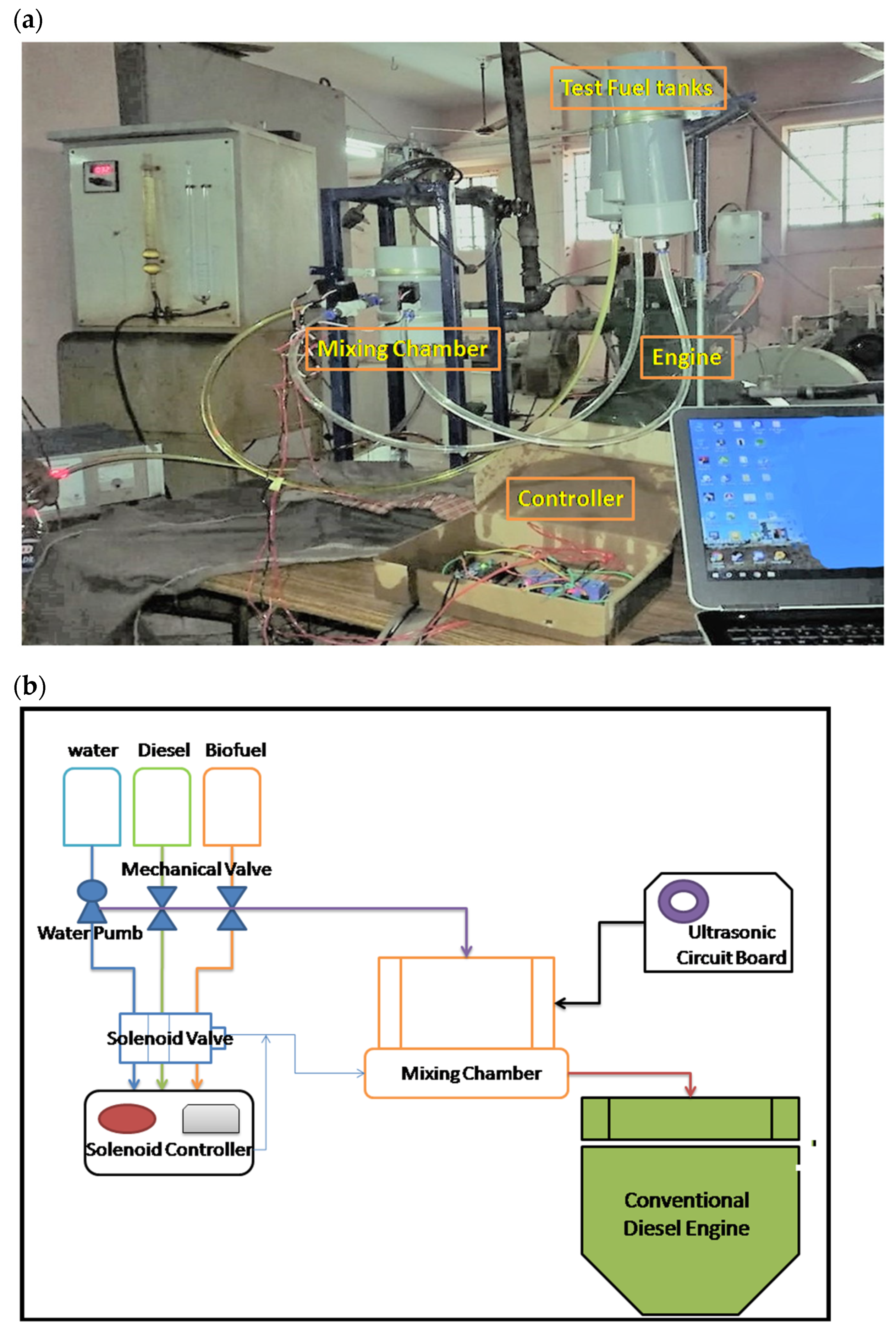



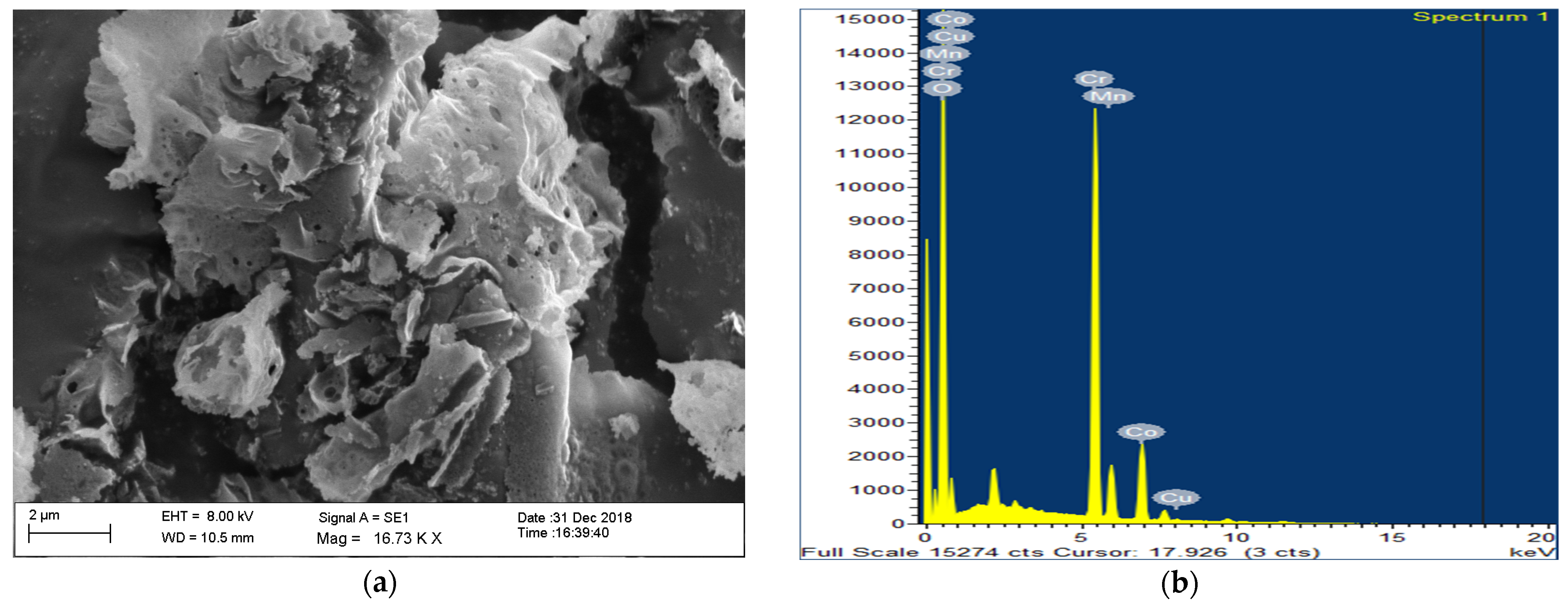

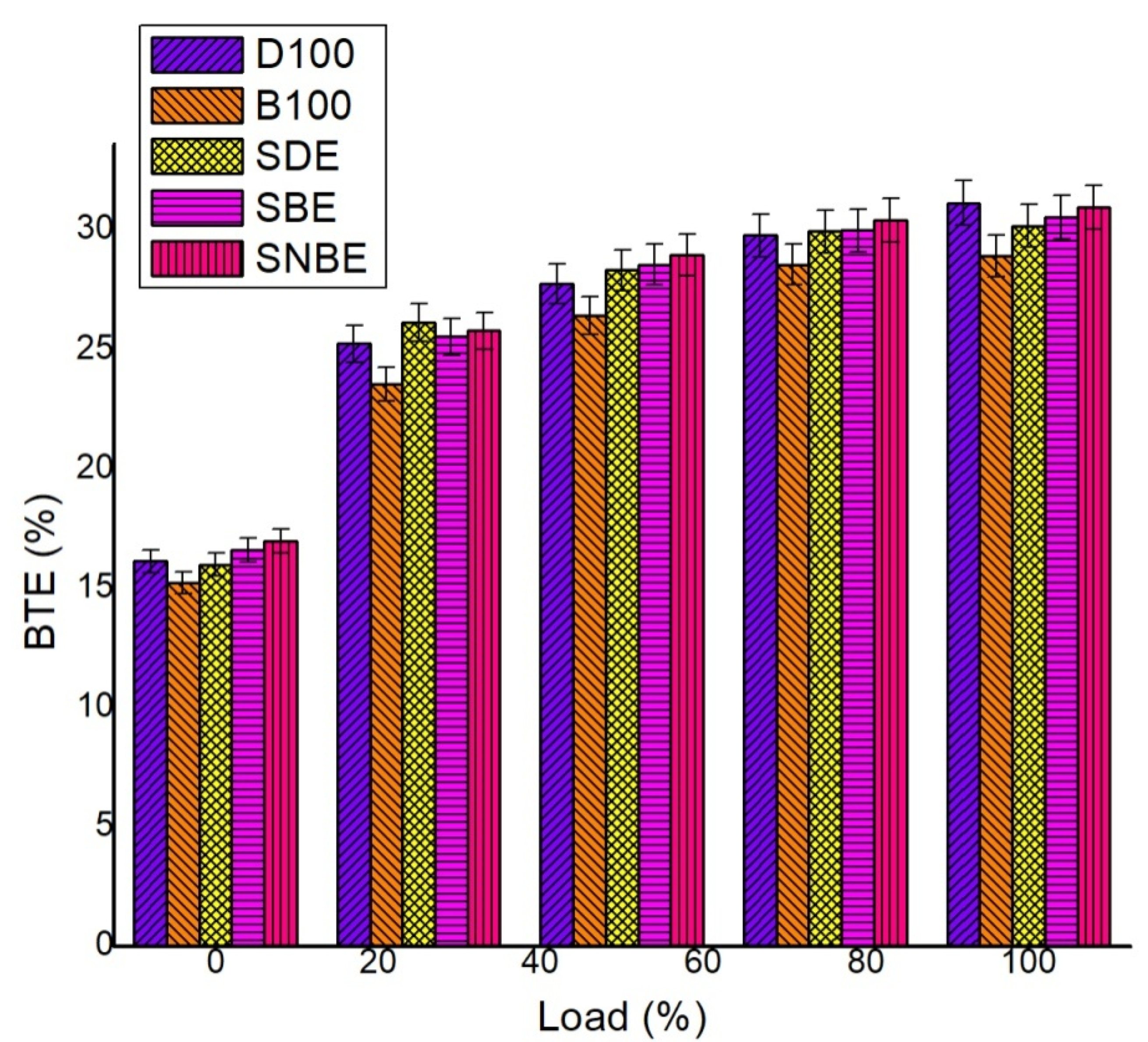
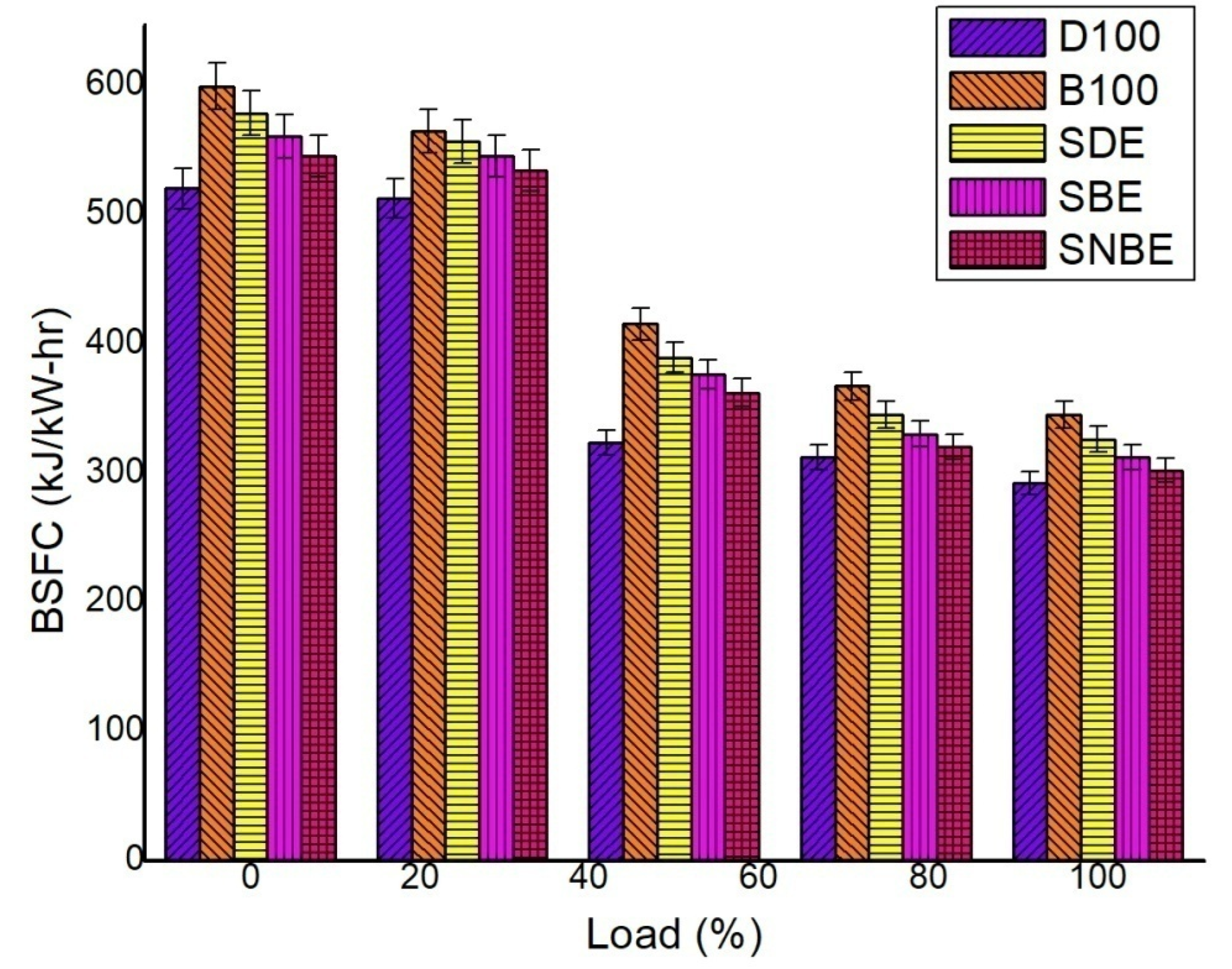

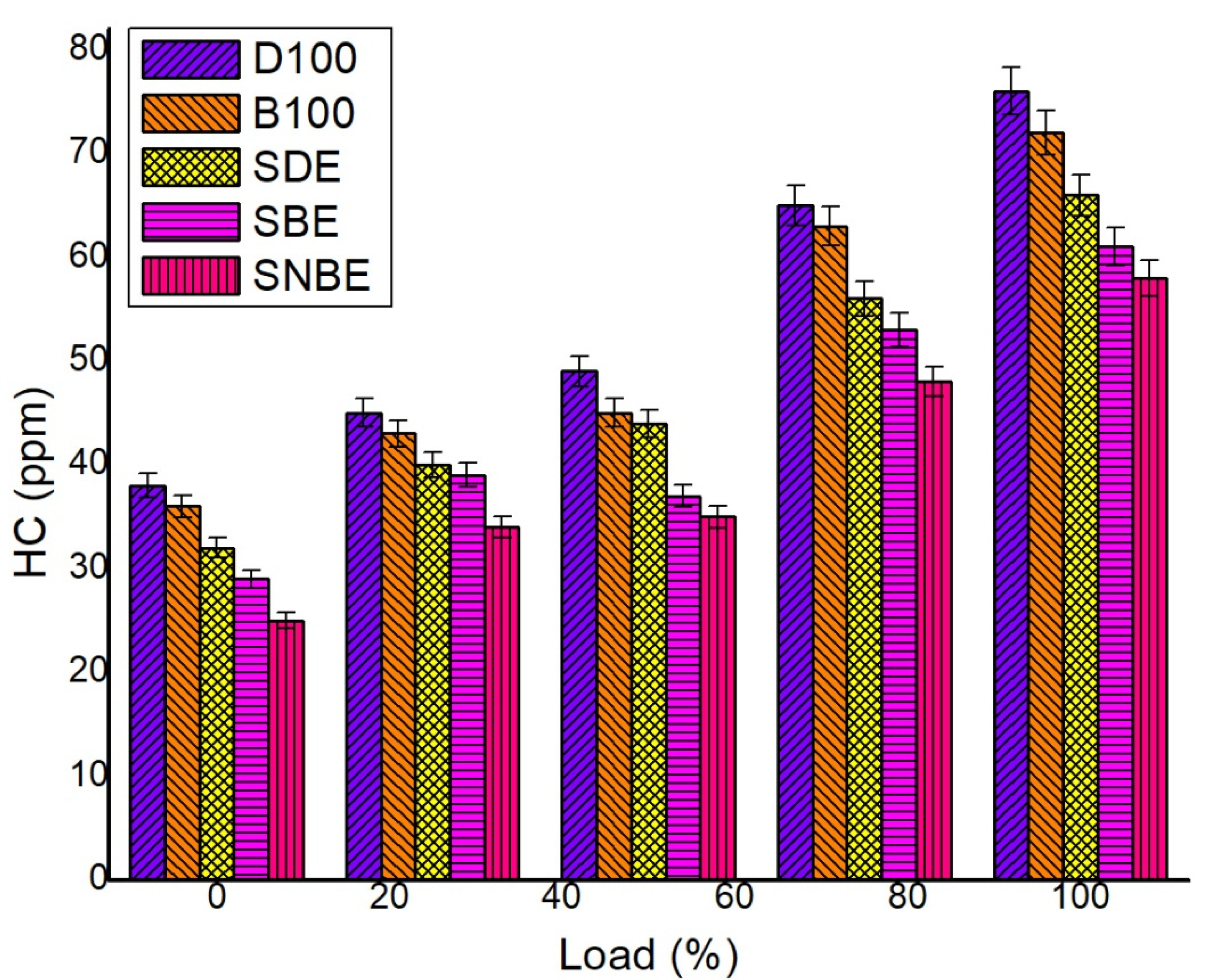
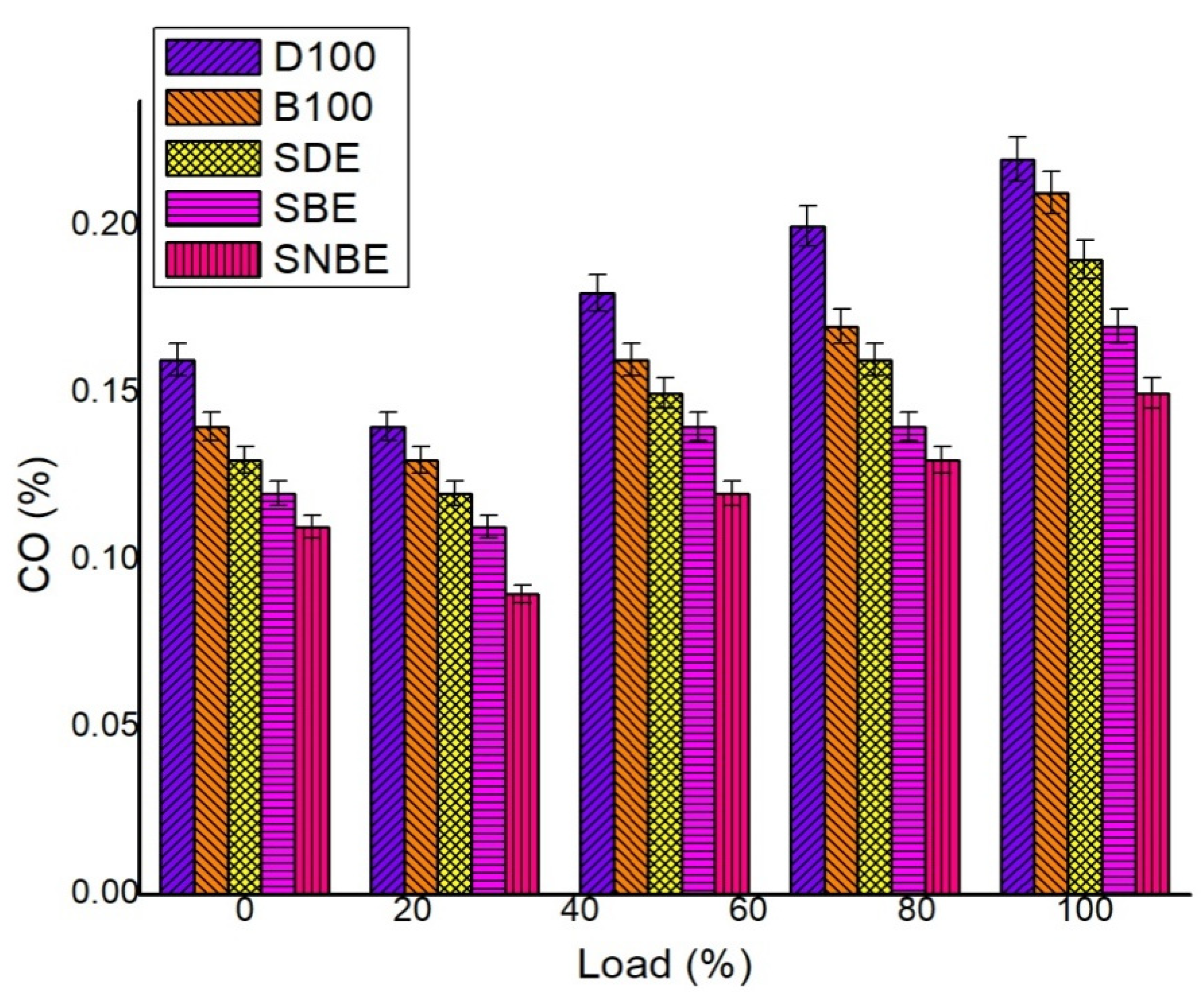

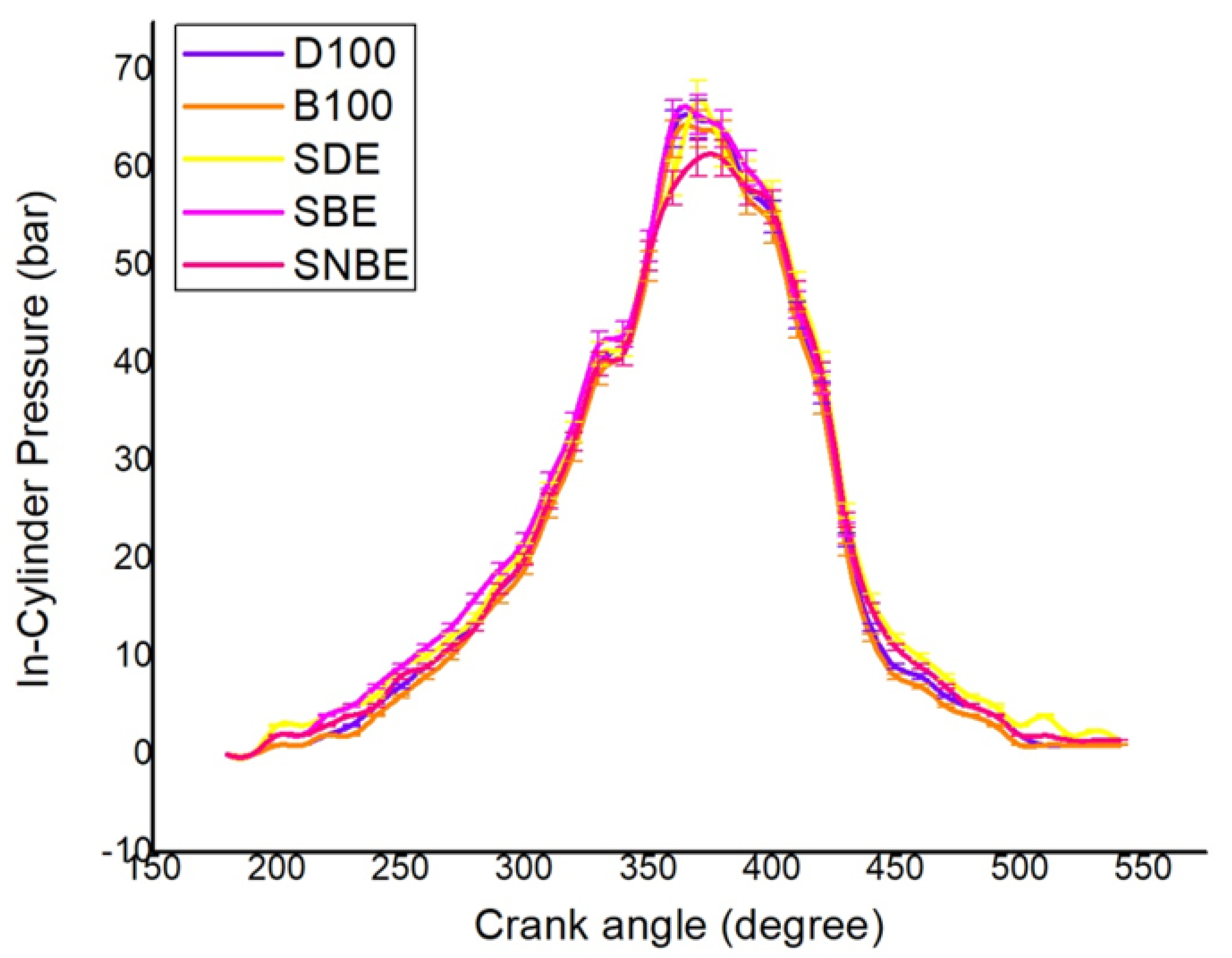

| Type of Fuel Blend | Performance | Emission Characteristics | Ref. | ||||
|---|---|---|---|---|---|---|---|
| BSFC | BTE | CO | NOx | HC | PM/Smoke | ||
| Jatropha (Al2O3) 100 ppm | ↓ | ↑ | ↓ | ↓ | ↓ | ↓ | [30] |
| Jatropha (Ti) 100 ppm | ↓ | ↑ | ↓ | ↓ | ↓ | ↓ | [30] |
| Jatropha (CNT) 100 ppm | ↓ | ↑ | ↓ | ↓ | ↓ | ↓ | [30] |
| Oenothera (GO) 100 ppm | ↓ | ↑ | ↓ | ↑ | ↓ | ↓ | [31] |
| Garcinia gummi (CeO2, ZrO2, TiO2) | ↓ | ↑ | ↓ | ↑ | ↓ | ↓ | [32] |
| WCO (CeO2 80 ppm) | ↓ | ↑ | ↓ | ↑ | ↓ | ↓ | [33] |
| Neat Palm Oil (SiO2) 10 and 20 ppm | ↓ | ↑ | ↓ | ↑ | ↓ | ↓ | [34] |
| Biodiesel—diesel (CNT, Ago 10, 20, 30 ppm) | ↓ | ↑ | ↓ | ↑ | ↓ | ↓ | [35] |
| WCO—Diesel (CNT 20, 40 and 100 ppm) | ↓ | ↑ | ↓ | ↑ | ↓ | ↓ | [36] |
| WOP (TiO2) 100 ppm | ↓ | ↑ | ↓ | ↓ | ↓ | ↓ | [37] |
| Soyabean nanoemulsion (ZrO2) 100 ppm | ↓ | ↑ | ↓ | ↓ | ↓ | ↓ | [38] |
| Nanoemulsion with Biodiesel (CNT 150 ppm) | ↓ | ↑ | ↓ | ↑ | ↓ | ↓ | [39] |
| Mustard oil—nanoemulsion (TiO2) 50 ppm | ↓ | ↑ | ↓ | ↓ | ↓ | ↓ | [40] |
| Rice bran—nanoemulsion (FeCl2) | ↓ | ↑ | ↓ | ↓ | ↓ | ↓ | [41] |
| Crude oil—nanoemulsion (Al2O3) 80 ppm | ↓ | ↑ | ↓ | ↓ | ↓ | ↓ | [42] |
| Properties | D100 (100% Diesel) | B100 (100% Citronella) | SDE (Surfactant-Free Diesel Emulsion) | SBE (Surfactant-Free Bioemulsion) | SNBE (Surfactant-Free Nano-Bioemulsion) |
|---|---|---|---|---|---|
| Calorific Value (MJ/kg) | 44.12 | 38 | 43.009 | 41.089 | 41.183 |
| Cetane number | 47 | 55 | 46 | 50 | 51 |
| Kinematic Viscosity (cSt) | 2.9 | 4.9 | 3.45 | 3.91 | 4.15 |
| Flash Pt (°C) | 66 | 55 | 68 | 64 | 66 |
| Density (kg/m3) | 820 | 900 | 843 | 871 | 844 |
| Make | Kirloskar TV-1 |
|---|---|
| Type | Four-stroke engine |
| Cooling | Water |
| Bae Engine Bore | 86.6 mm |
| Bae Engine Stroke | 112 mm |
| Compression ratio | 17.6:1 |
| Power Rating | 5.1 kW |
| Speed | 1500 rpm |
| IT | 23deg before TDC |
| Nozzle | 0.3 mm and three nozzles |
| Bowl | Hemispherical |
| Instruments | Type | Manufacturer | Measuring Range | Standard Error |
|---|---|---|---|---|
| Smoke Meter | AVL Smoke meter | AVL India Pvt. Ltd. (Gurugram, India) | 0 to 100 HSU | ±0.1 |
| Five-gas analyzer | Krypton 290 five-gas analyzer | SMS Auto Line Equipment Pvt. Ltd. (Chennai, India) | CO—(0–10%) CO2—(0 to 20%) HC—(0 to10,000 ppm) O2—(0 to 25%) NOx—(0 to 5000 ppm) | ±0.1 ±0.1 ±0.05 ±0.02 |
| Test No. | Test Abbreviations | Load | Base Fuel | Water Concentration | Nanoadditive Concentration |
|---|---|---|---|---|---|
| 1 | D100 | Variable 0–100% (Constant speed 1500 rpm, IT 23 degCA, IP 200 bar) | Diesel fuel (100%) | - | - |
| 2 | B100 | Variable 0–100% (Constant speed 1500 rpm, IT 23 degCA, IP 200 bar) | Citronella fuel (100%) | - | - |
| 3 | SDE | Variable 0–100% (Constant speed 1500 rpm, IT 23 degCA, IP 200 bar) | Diesel (95%) | 5% | - |
| 4 | SBE | Variable 0–100% (Constant speed 1500 rpm, IT 23 degCA, IP 200 bar) | Citronella fuel (25%) + Diesel (70%) | 5% | - |
| 5 | SNBE | Variable 0–100% (Constant speed 1500 rpm, IT 23 degCA, IP 200 bar) | Citronella fuel (25%) + Diesel (70%) | 5% | 100 ppm |
| S.no | Measured Parameters | Percent Uncertainty |
|---|---|---|
| 1. | BTE | 0.4% |
| 2. | BSFC | 0.6% |
| 3. | Pressure | 0.2% |
| 4. | BP | 0.4% |
| 5. | Crank angle encoder | 0.05% |
| 6. | Engine Speed | 0.1% |
| 7. | Dynamometer Load | 0.2% |
Publisher’s Note: MDPI stays neutral with regard to jurisdictional claims in published maps and institutional affiliations. |
© 2022 by the authors. Licensee MDPI, Basel, Switzerland. This article is an open access article distributed under the terms and conditions of the Creative Commons Attribution (CC BY) license (https://creativecommons.org/licenses/by/4.0/).
Share and Cite
Ramalingam, K.; Perumal Venkatesan, E.; Aabid, A.; Baig, M. Assessment of CI Engine Performance and Exhaust Air Quality Outfitted with Real-Time Emulsion Fuel Injection System. Sustainability 2022, 14, 5313. https://doi.org/10.3390/su14095313
Ramalingam K, Perumal Venkatesan E, Aabid A, Baig M. Assessment of CI Engine Performance and Exhaust Air Quality Outfitted with Real-Time Emulsion Fuel Injection System. Sustainability. 2022; 14(9):5313. https://doi.org/10.3390/su14095313
Chicago/Turabian StyleRamalingam, Krishnamoorthy, Elumalai Perumal Venkatesan, Abdul Aabid, and Muneer Baig. 2022. "Assessment of CI Engine Performance and Exhaust Air Quality Outfitted with Real-Time Emulsion Fuel Injection System" Sustainability 14, no. 9: 5313. https://doi.org/10.3390/su14095313
APA StyleRamalingam, K., Perumal Venkatesan, E., Aabid, A., & Baig, M. (2022). Assessment of CI Engine Performance and Exhaust Air Quality Outfitted with Real-Time Emulsion Fuel Injection System. Sustainability, 14(9), 5313. https://doi.org/10.3390/su14095313









